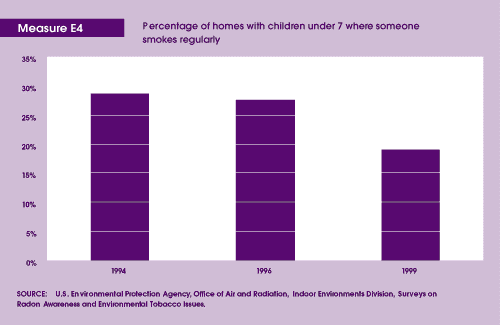Source: Environmental Contaminants: Indoor Air Pollution - EPA
January 2001
Children can be exposed to a number of air pollutants inside homes, schools, and other buildings. Some
of these pollutants come from indoor sources, including emissions from combustion sources such as gas stoves,
fireplaces, and secondhand tobacco smoke; off-gassing from building materials such as treated wood and paints,
furnishings, carpet, and fabrics; and consumer products such as sprays, window cleaners, and laundry soap.
Exposure to environmental tobacco smoke has been recognized as an important health risk for children.
Information on the toxic effects of other important indoor pollutants indicates that they could pose health
risks to children. We will continue to explore data sources for other indoor air pollutants to include
in future reports.
Children who are exposed to environmental tobacco smoke, also known as secondhand smoke, are at increased risk
for a number of adverse health effects, including lower respiratory tract infections, bronchitis, pneumonia,
fluid in the middle ear, asthma symptoms, and sudden infant death syndrome (SIDS). Exposure to environmental
tobacco smoke also may be a risk factor contributing to new cases of asthma. Young children appear to be more
susceptible to the effects of environmental tobacco smoke than older children are.
Smoke in the Home
Environmental tobacco smoke in the home is an important source of exposure because children spend most of
their time at home and indoors. This report's measure for environmental tobacco smoke is the percentage of
homes with children under 7 in which someone smokes regularly. This measure is a surrogate for
the exposure of children to tobacco smoke, and the data are based on a national survey. Data are
available for three of the 10 target years. The measure reflects the percentage of homes, rather
than children, although it is expected that the two would track closely.

a.. The percentage of homes with children under 7 in which someone smokes on a regular basis decreased
from 29 percent in 1994 to 19 percent in 1999.
b.. The percentage of homes with children under 7 in which someone is a smoker is greater than the
percentage in which someone is allowed to smoke in the home.
c.. Most often the smoker in the home is one of the parents.
d.. The decline in the percentage of children exposed to environmental tobacco smoke in the home
is similar to the decline in the percentage of adults who smoke.
back
InfoImagination © 2001 -- All Rights Reserved